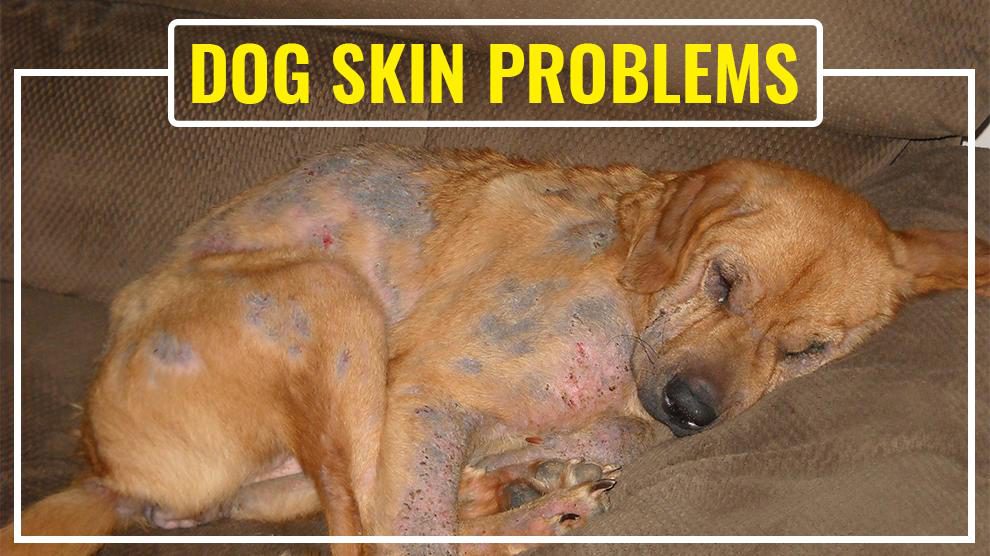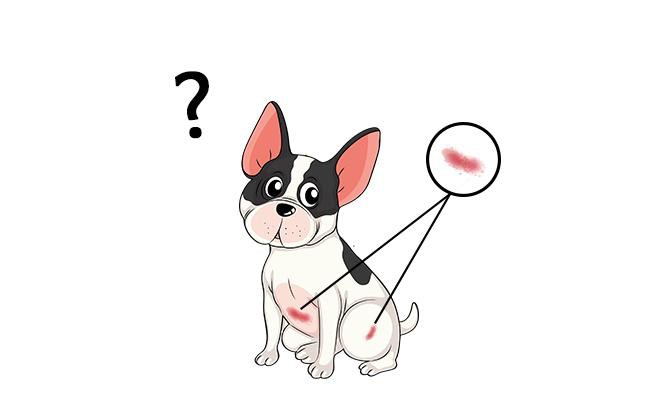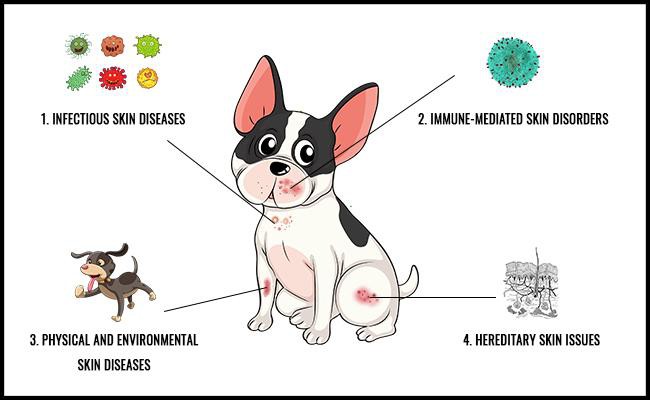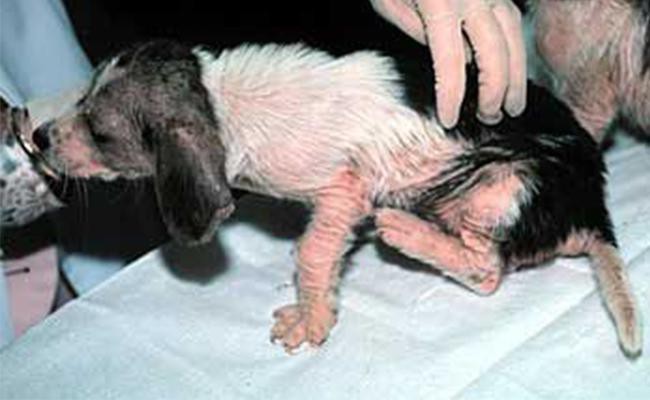Dog Pregnancy Calculator And Timeline
Is your dog’s skin becoming dry, often? Does your pooch scratch and lick its skin, incessantly?
Don’t worry. Dry, itchy skin is the common skin problem found in canines. The vets see dog skin problems as a common health complaint from dog owners.
Around 160 different types of skin disorders are found in dogs. Some are chronic and these cases account for up to 10% of animal hospital file folders.
The culprits behind the problem can generally be parasites, allergies, and underlying illness. But, the extreme conditions are summer and winter for your dog’s skin health.
Humidity, temperature extremes, and rain may also wreak havoc on your dog’s coat.
So, you and the veterinarian should work as a team and be proactive promptly in case of skin issues in canines. But, there are a few challenges in veterinary medicine.
There are several allergic skin disorders found in dogs. As a dog owner, you must know the most common dog skin problems and the ways to prevent it to keep your dog’s skin healthy.
What Causes Skin Problems In Dogs?
Several causes lie behind skin issues in dogs. Generally, environment, parasites, and nutrition play major roles in skin disorders in canines.
Parasites
They are the major cause of skin issues in dogs. Generally, parasites such as fleas and ticks cause inflammation, excess itching, and hair loss in canines.
But, mites such as Cheyletiella can also cause skin problems in dogs. So, it is advisable to check your pooch with the vet to for mite infestation.
Infection
Dogs can develop skin issues because of fungal, bacterial, or yeast infections. Ringworm is a common fungal infection in dogs. The fungus called “dermatophyte” causes ringworms in dogs.
Yeast infections can also cause skin diseases such as Malassezia pachydermatis, which is a secondary health problem in dogs. The vet may prescribe antifungal or antibiotic medications to your pooch to address this kind of dermatitis.
Environment
Your dog’s skin may be sensitive to lawn grass and this leads to itching and discomfort in canines. Moisture will also get trapped in your dog’ skin and cause hot spots.
Dogs having long, thick coats and those which are prone to matting will usually develop hot spots. In severe cases, your dog may get hair loss, too!
Several factors can cause skin issues in dogs.
- Dust
- Mold
- Pollen
- Other airborne allergens
Nutrition
Although nutrition plays an important role in your dog’s development, they may be the cause of skin diseases in dogs.
Proteins in beef, chicken, eggs, fish, lamb, and pork can cause skin allergies in your dog. Similarly, plant-based proteins from wheat and dairy products tend to contribute excess scratching and skin irritation in canines.
What Are The Types Of Dog Skin Problems?
Skin diseases in dogs are of various types depending on their cause and the time they last. As your pooch may get skin issues due to several causes, the skin disorders are classified into
- Infectious skin diseases
- Immune-mediated skin disorders
- Physical and environmental skin diseases
- Hereditary skin issues
Infectious Skin Diseases In Dogs
Fungi, virus, and bacteria can cause infections in dogs and lead to skin problems in them. Such diseases may spread from your pooch to other organisms and some won’t spread as well. The most common infectious skin issues in dogs are
- Sarcoptic mange
- Tick bites
- Demodicosis
- Flea Bites
- Alabama Rot
Sarcoptic mange or scabies is the common infectious skin disease in dogs and it can spread to humans. But, demodicosis in your pooch, caused by a mite named Demodex, is a non-spreadable disease.
Alabama rot has been on the rise in canines nowadays. Almost 25% of kidney failure in dogs occurs due to this deadly disease.
If your pooch’s immune system is either overactive or underactive, it may result in a few skin diseases. Your doggy will get the following skin diseases if its immune response is not sufficient.
- Atopic dermatitis
- Discoid lupus erythematosus
- Pemphigus
The most common autoimmune disease in dogs is Pemphigus foliaceus. Crusts may initially form in the dog’s face and ears, but they may spread to the whole body.
The vet may prescribe steroids, azathioprine, and other drugs to treat these disease.
Physical and environmental skin diseases
Your dog may get hot spots due to its licking habit. Hot spots or acute moist dermatitis is an itchy, painful skin lesion that results from constant scratching, licking, and biting of a specific skin area.
The skin lesion will become warm due to inflammation. A hot spot can spread fast and corticosteroid medication is used to treat it.
The vet may prescribe oral and topical antibiotics to treat the lesions. Generally, dogs having thick undercoat are prone to hot spots.
An acral lick granuloma is yet another skin disease in canines due to incessant licking. The dog’s wrist or ankle area is ulcerated usually.
Hereditary and developmental skin diseases
Some skin diseases in dogs are the result of inherent abnormalities of your dog’s skin structure or function. Those include
- Canine follicular dysplasia
- Color dilution alopecia
- Ichthyosis
- Juvenile cellulitis
- Seborrhea
- Skin fragility syndrome
Puppy strangles or juvenile cellulitis is a skin disease in puppies that occur due to a hereditary component related to the immune system.
As skin issues in dogs vary depending on the time they last and treatment, you can classify them into
- Curable
- Non-curable
Curable skin disorders
These diseases can be self-limiting problems and chronic that require treatment for a long time.
The following diseases in dogs are considered curable.
- Bacterial dermatitis
- Malassezia
- Seborrhea
As healthy dogs may also develop bacterial dermatitis, a proper diet will help to treat it. But, other skin disorders such as Malsssezia are curable, but your pooch may take several weeks to recover.
Generally, your dog’s new skin cell will take 4 weeks to mature. So, the canines may take more than 4 weeks to get complete recovery from the curable skin diseases.
Non-curable Skin Disorders
These skin disorders can be a nightmare for the dog, frustrating to the dog owner and the veterinarian. The following skin problems are non-curable and you can say them as chronic diseases.
- Atopic dermatitis
- Ichithysios
- Pemphigus
Specific diets including fatty acids and vitamin supplements and medications such as sprays and shampoos can control the ongoing skin disorder.
So, the vets should understand what is happening to and within the skin before prescribing therapeutics.
Dogs prone to these diseases are generally prescribed antibiotics for 8 to 12 weeks and sometimes they require medications much longer, too!
Common Skin Diseases In Dogs
Dogs usually have itchy skin, allergies, sores, hair loss and hot spots as a result of skin disease. Although umpteen number of skin disorders are found in dogs, the following are considered as the common skin problems in them.
(due to scratching, itch)
1. Acral Lick Granuloma
It is a frustrating skin condition in dogs and any dog breed may be prone to it. The condition is also called acral lick dermatitis and it occurs mostly in medium to large breeds. But, Labrador Retriever, Doberman Pinscher, Golden Retriever, Great Dane, and Irish Setters are more prone to this disease.
If your dog gets this health condition, it will
- Lick a specific area relentlessly, most often licking its forelimbs.
- Feel itching and pain in the affected area and healing won’t occur easily.
- Lick on the same spot.
Causes
Physical or psychological causes will lead to this condition. But, you can’t predict the exact cause of it. Infection, allergies, and joint pain are the physical causes of this disease. But, anxiety, fear, and obsessive-compulsive disorder can also cause acral lick granuloma.
Other causes include
- Boredom and anxiety
- Dog’s licking habit
- Self-stimulation due to separation anxiety
- Insect sting
- Joint or bone pain, which will lead your dog to lick over the top joint to eliminate discomfort.
- Hypothyroidism
Treatment
Discouraging your dog from licking habit is one of the ways to treat this disease. A bad-tasting topical solution may help your pooch to overcome the licking habit.
You can also use an Elizabethan collar to avoid licking habit in dogs. But, it won’t work well because your dog may lick again the affected area after its removal.
Similarly, a bitter apple or hot sauce can also be used to treat this condition. But, they also won’t yield you good results.
But, surgical instrumentation is a useful tool to treat this condition in canines. Some therapy is used to keep the dog away from the skin lesion for the healing of the affected skin area.
The vet may prefer laser surgery to remove the affected tissue by vaporizing the surface layers. But, other medications such as corticosteroids can also help your canines.
2. Folliculitis
It is nothing but a bacterial infection. Your pooch’s hair follicles are prone to infection and it is a common health condition in canines. Folliculitis can also cause bumps, sores, and scabs on the dog’s skin.
Your dog will get irritation because of folliculitis, but it can indicate any underlying health problems such as mange, allergies, or injury.
Symptoms
Swelling, itching, redness, and hair loss are the most common symptoms of this condition. But, the following symptoms may also be evident in folliculitis.
- Darkening of dog’s skin (i.e. hyperpigmentation)
- Pain around the affected area
- Superficial erosions
- Circular areas of hair loss with scaling or crusting around their borders
Dull coat and shedding with scaly skin are the major symptoms of this health condition in dogs having longhair. You can easily see the skin abnormalities in shorthaired dogs.
Treatment
Your doggy can’t easily get rid of folliculitis without getting veterinary assistance. The vet may diagnose it upon visual inspection. He may also advise you to take tests for your dog such as fungal culture, skin cytology, skin biopsy, and histopathology, etc.
Treatment involves the usage of more antimicrobial drugs. It involves three steps as well: topical, systemic, and underlying disorder. Topical therapy involves the usage of antimicrobial shampoos and systemic therapy usually includes oral antibiotics.
But, folliculitis generally requires both therapies for 3 to 12 weeks. But, the treatment for the underlying condition depends on the specific disorder.
3. Sarcoptic Mange
It is contagious skin disease in dogs and the mite Sarcoptes scabiei is the predominant cause for it. These mites will cause severe itching and irritation in your pooch.
It leads further to extensive scratching and results in hair loss. This disease typically affects your pooch’s belly, chest, and ears area. It can also appear anywhere on your dog’s body.
- But, the most common cause of this disease is the exposure to another infected animal. Kennels, dog parks, animal shelters, and veterinary clinics have high exposure to this disease. After exposure, it generally occurs in your pooch about 2 to 6 weeks before displaying the first symptom.
Symptoms
- Rashes on your pooch’s skin
- Excess scratching
- Crusts in the affected area
- Hair loss
Treatment
The vet may prescribe Scabicide, a drug, to kill the mite. In some cases, a scabicidal shampoo will help to kill the living mites. But, ongoing treatment is necessary to kill the eggs of mites, too.
It is advisable to treat this condition under veterinary supervision. But, selamectin, lime-sulfur, doramectin, and selamectin are also used to treat this issue. Oral medications can also be a part of the treatment.
But, depending on your dog’s condition, your dog may need dipping every week for 6 consecutive weeks. So, contact your vet as soon as you see mild symptoms such as flakes on the dog’s skin.
4. Seborrhea
It is a skin condition in dogs that will cause dandruff and greasiness in your dog’s skin and hair. A common disorder, seborrhea may cause secondary infection in your dog’s skin. Dogs affected with this condition will smell bad due to the buildup of oil on the skin and hair.
It usually affects your pooch before it reaches 2 years of age and progresses while your dog gets older. The following dog breeds are prone to seborrhea.
- American Cocker Spaniels
- Dachshunds
- English Springer Spaniels
- German Shepherds
- Golden Retrievers
- Labrador Retrievers
- West Highland White Terriers
Causes
Dogs may have seborrhea as either as a primary disease or secondary to another disease process. Primary conditions that can lead to seborrhea include
- Allergies
- Autoimmune disorders
- Dietary deficiencies
- Endocrine disorders
- Malabsorption disorders
- Parasites
Symptoms
- Bleeding
- Clumps of greasy substance in your pooch’s ears, elbows, under the belly, and around the ankles
- Crusts
- Scratching
Treatment
It is quite impossible to cure this disease in dogs. So, treatment focuses on controlling the condition using a combination of shampoos and conditioners to keep the skin clean.
Shampoos will include salicylic acid, benzoyl peroxide, sulfur, and coal tar. Consult the vet for the best combination of shampoos and frequency of bathing.
Fatty acids and vitamin supplements may help in controlling seborrhea. Sometimes, your dog may need antibiotics and antifungal medications.
So, consult the vet for an appropriate dietary supplement for your dog. Always, keep your pooch clean and well hydrated to reduce the chances of a secondary infection.
Also, schedule regular follow-up examinations with the vet to monitor the dog’s skin condition.
5. Pyoderma
It is the most common skin infection in canines, which can be fungal, bacterial, or the result of a mite. The infection results in pus called “pyoderma.” Cut or wounded skin or scratched the skin of your dog is more prone to such kind of infection.
Pyoderma is referred to as impetigo in young puppies. The infection can also occur on the in the inner folds of your dog’s skin and it is referred to as deep pyoderma.
Causes
If your pooch has wound on its skin due to flea bite or other irritation, it will either chew or scratch the area. This will cause further disruption in the skin and allows bacteria to overgrow.
But, your dog may scratch their skin due to any of the following.
- Food allergies
- Allergens such as dust mites, grass, and mold
- Cushing’s disease
- Over-grooming
- Hypothyroidism
Overgrowth will cause itchiness in your dog’s skin and make the infection worsen. While it can occur in any breed, a few breeds are prone to develop this condition, including
- Boston Terrier
- French Bulldog
- Shar-Pei
- Pitbull Terrier
- American Cocker Spaniel
Symptoms
- Itchiness
- Dried discharge in the affected area
- Hair loss
- Redness
- Crusted skin
- Small, raised lesions
Treatment
Pyoderma can be treated with medications. Treatment generally involves cleaning the infection using topical medications. The vet may also prescribe oral antibiotics to treat pyoderma.
If your pooch has more yeast infection, the vet may prescribe antifungal medication as well. So, it is advisable to follow the vet’s advice to reduce the likelihood of infection.
How To Prevent My Dog From Getting Skin Problems?
You can prevent your pooch from getting skin problems in several ways. Generally, many skin disorders in canines occur due to poor nutrition.
But, the supplementation of both omega-3 and omega-6 fatty acids will help to reduce inflammation in chronic skin diseases.
Deficiency in omega-6 fatty acids leads to a high risk of infection in dogs and reduced ability to heal. But, lipids help for skin health by nourishing the skin and retaining moisture to prevent flaky, dry skin.
Vitamins A and E play a major role in the maintenance of your dog’s skin health. Minerals act as an antioxidant for your pooch’s health. Selenium, the essential nutrient, should be present in trace amounts in your dog’s diet.
Regular grooming and brushing will keep your dog from mats and infectious insects.
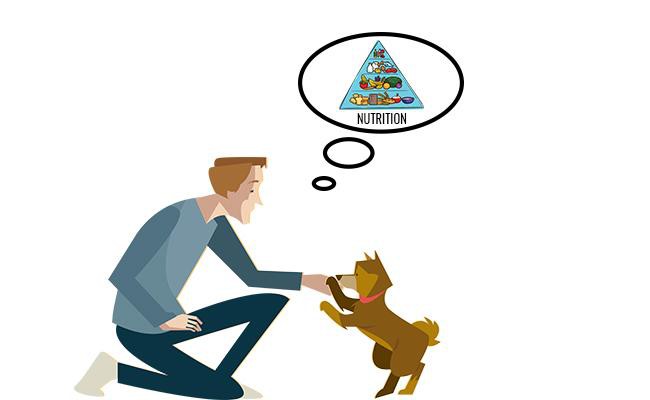
A few tips can help you to prevent your pooch from skin issues.
- If your dog has itching, check for the cause of it by combing your hand against the dog’s hair. You will be able to see the fleas jumping all over the hair. In such cases, provide medications such as Frontline, Bio spot, and Advantix regularly to your pooch during warm months.
- For prolonged itching in dogs that causes sleepless nights to your doggy, Benadryl is the best solution. You can give 1 milligram per pound of your dog’s body weight twice daily. But, ensure that the dosage doesn’t exceed 50mg.
- New food may cause troubles to your dog. So, if you find worse reactions in your pooch, try to switch back the foods to older ones.
- After bathing your dog, leave it in conditioner.
- Fish oils are rich in omega-3 fatty acids. So, you can give fish oil capsules to your dog at mealtime. You can give 1000mg once a day for the average-sized dog, slightly less for smaller dogs, and slightly more for larger dogs.
Bottom line
Control is the goal if you know there’s no cure.

